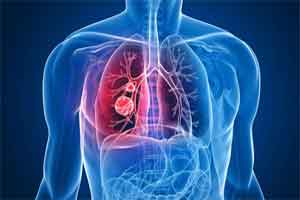- Home
- Editorial
- News
- Practice Guidelines
- Anesthesiology Guidelines
- Cancer Guidelines
- Cardiac Sciences Guidelines
- Critical Care Guidelines
- Dentistry Guidelines
- Dermatology Guidelines
- Diabetes and Endo Guidelines
- Diagnostics Guidelines
- ENT Guidelines
- Featured Practice Guidelines
- Gastroenterology Guidelines
- Geriatrics Guidelines
- Medicine Guidelines
- Nephrology Guidelines
- Neurosciences Guidelines
- Obs and Gynae Guidelines
- Ophthalmology Guidelines
- Orthopaedics Guidelines
- Paediatrics Guidelines
- Psychiatry Guidelines
- Pulmonology Guidelines
- Radiology Guidelines
- Surgery Guidelines
- Urology Guidelines
A simple blood test to rule out lung cancer accurately

More than 1.6 million lung nodules are detected in patients in the US every year out of which 75 to 85 percent turn out to be benign but they can pose a diagnostic dilemma for doctors.A simple blood test may quickly evaluate and treat patients with cancerous nodules, while never exposing patients who don't have cancer to invasive costly risky procedures.Gerard A. Silvestri, a lung cancer pulmonologist at the MUSC Hollings Cancer Center and colleagues conducted a study to evaluate the accuracy of a simple blood test for lung cancer.The researchers found that blood test or biomarker was 98 percent effective at distinguishing benign from malignant nodules.The study has been published in Journal Chest.
"The researchers at the Medical University of South Carolina (MUSC) participated in a multicenter clinical trial to evaluate the accuracy of a blood test, or "biomarker," that measures the levels of two proteins in a patient's plasma, LG3BP, and C163A, integrated with clinical predictors of cancer, such as age, size of the nodule and other nodule characteristics. These proteins are common predictors of lung cancer. In the study, the biomarker was 98 percent effective at distinguishing benign from malignant nodules.
This research is part of the Pulmonary Nodule Plasma Proteomic Classifier (PANOPTIC) study.The clinical trial included 685 patients of 40 years old or older, with newly discovered lung nodules 8 to 30 millimeters in diameter as shown on a recent (fewer than 60 days old) CT scan.The biomarker works like this: If a patient has less than a 50 percent chance of having cancer and the test result is negative for the integrated classifier, it's likely not cancer. The biomarker can offer the provider confidence in a diagnosis and treatment plan.
"It serves as a 'rule out' test for those with low-to-moderate risk," says Silvestri. "The biomarker is a tool to help calculate the general risk of cancer and present a patient with recommendations and options. It can push people out of indeterminate risk and into low-risk -- without having to undergo invasive and potentially risky procedures."
"Think of your lung as a two-liter bottle of soda, and the nodule as a pea in the center of it," explains Silvestri. "During a biopsy, for example, the lung could collapse and need a tube to expand it. Our goals for this biomarker are to help calculate the risk of cancer, present the patient with options and recommendations and avoid subjecting patients with the benign disease to expensive, unnecessary and intrusive procedures."
Even if biomarker results are negative, patients will need ongoing CT scans to monitor a lung nodule. "A low-risk tumor will be followed with serial imaging. After two years of CT scans being performed periodically and without evidence of growth, we can say it's benign," Silvestri says.
If the biomarker's results in the PANOPTIC study had been used to direct care (they were not), 40 percent fewer procedures would have been performed on patients with benign nodules. The next step in bringing this test to the clinic would be to conduct a "clinical utility" study to show how using this biomarker might affect physician and patient behavior.
For further reference log on to: http://dx.doi.org/10.1016/j.chest.2018.02.012

Disclaimer: This site is primarily intended for healthcare professionals. Any content/information on this website does not replace the advice of medical and/or health professionals and should not be construed as medical/diagnostic advice/endorsement or prescription. Use of this site is subject to our terms of use, privacy policy, advertisement policy. © 2020 Minerva Medical Treatment Pvt Ltd